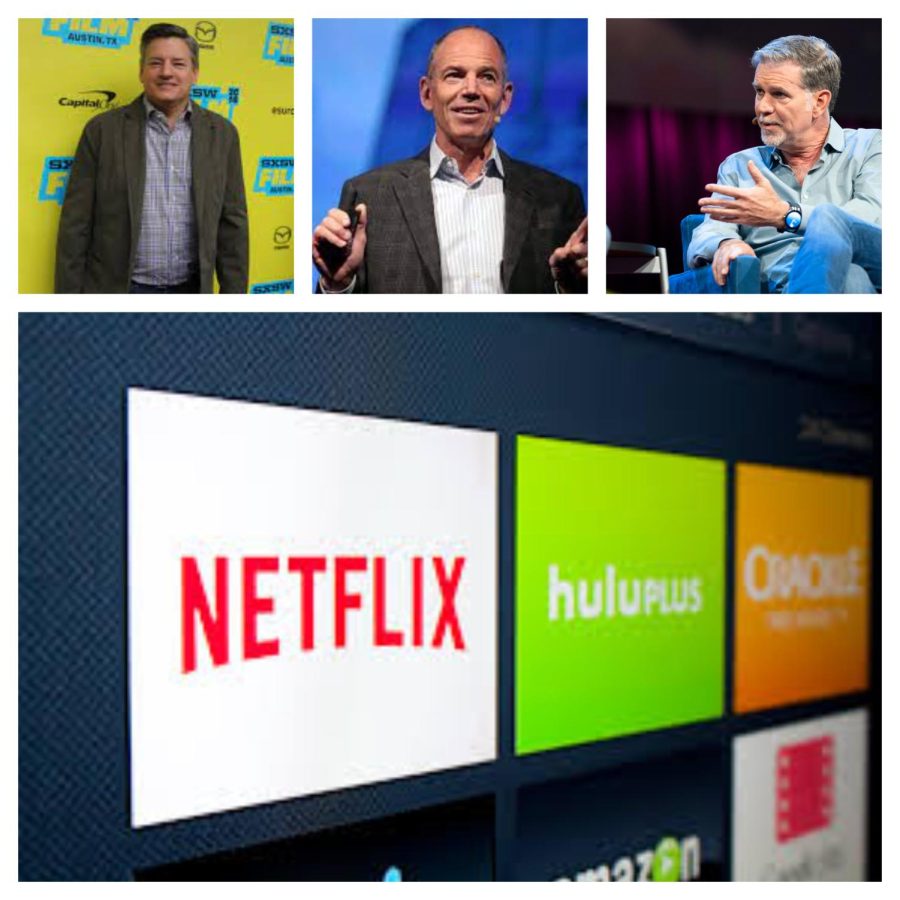How Netflix originated
Ted Sarandos (left), Marc Randolph (middle) and Reed Hastings (right) have helped start and modify Netflix.
December 14, 2021
Netflix is the most popular streaming service in the world. Many kids, teenagers and adults are fully engaged with the infinite selection of movies and shows available on its platform. While only charging $9-$18 per month depending on the plan, Netflix is quite affordable considering the fact that they have over 3,000 movies and shows to choose from. But how did Netflix come to be? That is a question many have asked.
Netflix was created in 1997 by Reed Hastings and Marc Randolph, but not entirely in the same way it is known as today. When they launched their campaign, the business was pretty much a DVD delivery service. They liked the idea of renting movies at cheaper prices and with no late fees. In fact, no deadlines for returning it at all. According to “How and When Did Netflix Start? A Brief History of the Company”, “after a few iterations in its first few years, Netflix eventually crafted a successful business model: a subscription-based service with no due dates or late fees and unlimited access to content at $19.95, a “Queue” that subscribers use to specify the order in which DVDs should be mailed to them, and a delivery system that automatically mails out a DVD as soon as the previous DVD is returned. The DVDs arrived in thinly packaged red envelopes with a postage-paid return sleeve inside. All postage costs were covered by Netflix.”
Now, why is Netflix called Netflix? To keep it simple, the first part “net” is an abbreviation for Internet, and “flix” was a variation of “flick” which was a common name for a movie or show. The first night it launched, the system crashed because so many users were interested which forced Hastings and Randolph to quickly buy more servers to keep up with the program, so even from the start, Netflix was a hit.
In 1999, Netflix turned into a subscription-based system, which was streamed on TV sets. Later in 2000, Hastings worked hard to personalize the system, meaning that the network would predict the members’ choices. After expanding to the whole U.S., the new streaming service was on a roll. In the article, “The Fascinating History of Netflix,” Christopher McFadden summarizes, “With a membership count at 600,000 in the US, Netflix makes its initial public offering (on the Nasdaq, under the ticker “NFLX”). The stock is initially offered for $15 a share, with an initial offering of 5,500,000 shares.”
However, everything is not always as it seems. In the midst of success, there can always be struggles and changes happening underneath the surface. In 2003, Netflix reached one million subscribers and celebrated its success. Randolph had stepped down as CEO of Netflix in 1999 giving his position fully to Hastings, and later in 2003, he stepped down completely and left Netflix as a whole. Hayley C. Cuccinello says in “Netflix Cofounder Marc Randolph On Why He Left, Becoming A Mentor And His Love Of Chaos” that, “His choice to leave Netflix and start mentoring go hand-in-hand. He missed the “scrappy, underdog days” of Netflix—brainstorming startup ideas in Hastings’ Toyota Avalon, working out of diners and a Best Western conference room, the thrills of succeeding and stumbling.” He liked the challenge that he faced at the beginning, and now that it was over and succeeding, Randolph realized it was time to move on.
From 2007 to 2015, Netflix grew exponentially and was introduced to different sources like smartphones, smart-TVs, etc. It partnered with different companies to expand all over the world and be as big as it is today.
Since then, it has been constantly growing and has been modified to fit the needs of its viewers. It has inspired other companies such as its competition like Hulu, Disney+, etc. Now, Netflix is co-owned by Hastings and Ted Sarandos, who work at it every day to make the most of the program. All in all, there is something to be said about taking risks and doing the best possible job to achieve something. Who knows where a simple idea can take you?









